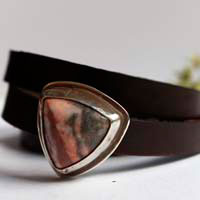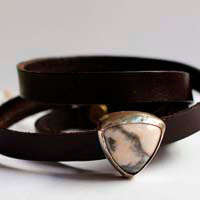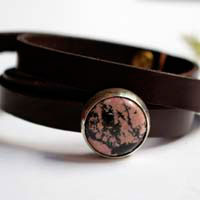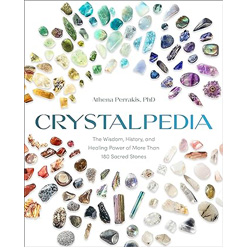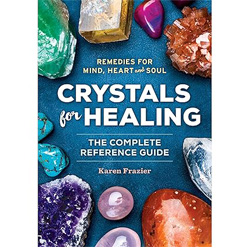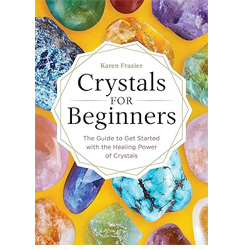- Jewelry
- Inspiration
- Our imagination
- Birthstones
- Celebrating with Eternal Flowers
- Druids and druidesses
- Flower meanings
- History, archeology jewelry
- History and healing properties of metals
- History and healing properties of stone
- Illumination jewelry
- Japanese symbols
- Maya calendar jewelry
- Stone color symbolism
- Stones catalogue
- Wedding anniversaries
- Searches a theme on the site
- Good Deals
- Paintings
- About
- Contact
JEWELRY
- Anklet
- Bracelets
- Brooches
- Cufflinks
- Earrings
- Pendants & Necklaces
- Rings
- Draw your jewelry
- How to clean your jewel
- Metal we used
INSPIRATION
- Our imagination
- Birthstones
- Celebrating with Eternal Flowers
- Druids and druidesses
- Flower meanings
- History, archeology jewelry
- History and healing properties of metals
- History and healing properties stones
- Illumination jewelry
- Japanese symbols
- Maya calendar jewelry
- Stone color symbolism
- Stones Catalogue
- Wedding anniversaries
- Searches a theme on the site
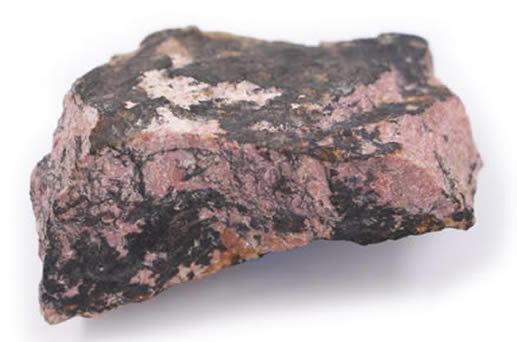
Rhodonite: history, healing properties and lithotherapy
Rhodonite properties
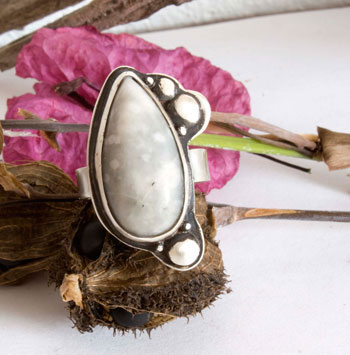
Rhodonite, discovered in 1819 by Christoph Friedrich Jasche from Ilsenburg, derives its name from the Greek rhodon, meaning "pink," in reference to its characteristic pink hue.
Rhodonite is also known by many other names, reflecting either its chemical properties or local variations: Manganese basilicate (a designation based on its chemical composition), Buslamite (a gray-red variety found in Mexico), Paisbergite (a name used locally in certain mines), Sesquimanganese silicate (a term derived from older chemical descriptions), and Cummingtonite (although this term is generally reserved for another mineral, it has occasionally been used to describe rhodonite-containing formations). Other historical names include Hermannite, Hydropite, Kapnikite, Mangan Amphibole, and Manganolite, all of which have fallen out of use but were once part of early mineralogical classifications. Additional terms such as Pink lithoid manganese, Pink siliceous oxidized manganese, Red siliceous oxidized manganese, Pink manganese silicate, and Pink manganese emphasize the mineral's manganese content and its distinctive hue. While some of these appellations are now obsolete, they reflect the mineralogical history of rhodonite and the evolution of scientific classifications.
This stone belongs to the silicate group, specifically the pyroxenoid family. It is primarily composed of manganese silicate (MnSiO₃), but it can also contain trace amounts of other elements such as iron, calcium, magnesium, and occasionally zinc, which influence its coloration and physical properties.
Rhodonite crystallizes in the triclinic system and is most commonly found in massive form. Well-formed crystals are rare and are mainly sourced from Russian and Swedish deposits. It has a hardness of 5.5 to 6.5 on the Mohs scale, making it relatively durable, though still fragile and prone to cleavage upon impact.
Its color ranges from pale pink to deep red, sometimes with orange or brownish hues depending on the iron content and other trace elements. It is often veined or interspersed with black manganese oxide inclusions (such as manganite, pyrolusite, or hollandite), giving it a marbled appearance highly valued in jewelry and ornamental applications.
Rhodonite primarily forms in manganese-rich metamorphic deposits, where it results from contact or regional metamorphism. It is often found in association with other manganese-bearing minerals, such as spessartine (a variety of garnet), rhodochrosite, bustamite, and tephroite.
Mines: Australia, Brazil, the USA, France, Sweden and Russia.
History, legends and beliefs about rhodonite
In ancient times, rhodonite was often given as a gift to express friendship. This tradition, dating back thousands of years, has endured through the ages, reflecting the symbolic and emotional value attributed to this precious stone. Due to its pink color, evoking tenderness and emotional bonds, it was also associated with fidelity and sincere love.
The Greeks and Romans, aware of the protective properties attributed to rhodonite, frequently wore it as amulets or talismans during their travels. It was believed to not only safeguard travelers from bandit attacks but also to promote serenity and prudence on the road. Some historical accounts suggest that Roman soldiers sometimes embedded rhodonite in their armor or accessories to enhance their courage and vigilance in battle.
In Asia, particularly in China and India, rhodonite was used in spiritual and medicinal practices. In traditional medicine, it was associated with emotional balance and the regulation of vital energy. Some Taoist masters believed that it fostered inner harmony and strengthened the connection between body and mind.
Rhodonite gained particular prominence in Russia, where it was extensively mined from the 19th century onwards. The discovery of vast deposits in the Ural Mountains quickly made it an emblematic stone of the country.
One of the most prestigious uses of rhodonite in Russia was its integration into the architecture and decorative arts of imperial palaces and cathedrals. Many artistic objects, such as monumental vases, columns, and sculptures, were crafted from massive blocks of rhodonite.
A remarkable example of this artistic use is the tomb of Maria Alexandrovna, wife of Tsar Alexander II, located in the Peter and Paul Cathedral in Saint Petersburg. Entirely made of rhodonite, this impressive sarcophagus is a masterpiece of lapidary art. The raw stone, extracted from the Urals, required 16 years of meticulous craftsmanship before being perfectly polished and installed in 1906. Today, this tomb is considered one of the finest examples of rhodonite use in funerary art.
Other monuments and prestigious objects made of rhodonite were commissioned by the Russian imperial court, including tables, columns, and ornaments for the grand halls of palaces in Saint Petersburg and Moscow. The stone, with its satin-like luster and unique hue, was particularly prized for its ability to enhance the grandeur of imperial architecture.
In Eastern Europe, rhodonite was believed to offer protection against negative energies and malicious intentions. Some believers placed pieces of rhodonite under their pillows or at their doorways to ward off the evil eye.
In certain Slavic traditions, rhodonite was considered a stone capable of soothing conflicts and restoring harmony in family relationships.
In North America, some Indigenous tribes used rhodonite as talismans to foster emotional resilience and overcome hardships.
Even today, rhodonite retains an important place in contemporary beliefs. It is frequently used in jewelry and lithotherapy, where it is regarded as a stone of emotional healing and inner peace.
Healing properties and benefits of rhodonite
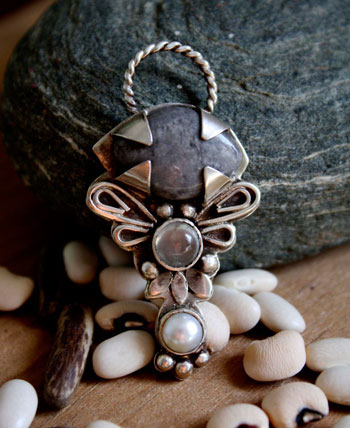
Throughout the long history of humanity, various societies have attributed to rhodonite a range of properties, virtues, and interpretations of a curative or symbolic nature. The elements presented here are part of a cultural, historical, and descriptive approach, intended to illustrate the symbolic relationship that has gradually developed between this stone and human civilizations over the centuries. As with the previous examples, this information is grounded in a scientific and historical perspective. It does not constitute a therapeutic or medical recommendation in any form, nor does it reflect personal beliefs.
- In some traditions, rhodonite has been associated with supporting individuals prone to stress, anxiety, and imbalances of the nervous system. It was sometimes described as a symbolic aid encouraging better emotional regulation, contributing to inner calm and a reduction in states of panic or nervous tension.
- Known in several traditional interpretations for its regulating role, rhodonite has also been linked to female cycles. It was mentioned as a symbolic accompaniment for menstrual discomfort and irregular cycles, within a holistic view connected to both physical and emotional balance.
- On a symbolic respiratory level, rhodonite has been associated with the lungs and the respiratory tract. Certain traditions referred to it in contexts related to asthma, bronchial conditions, or seasonal sensitivities, linking it to freer breathing and the easing of tension in the chest.
- Rhodonite has also appeared in traditions concerned with visual comfort. In some contexts, it was associated with eye strain or age-related vision issues, symbolizing rest, clarity, and the recovery of overworked visual functions.
- In traditional readings focused on elimination processes and bodily structure, rhodonite has been associated with the symbolic drainage of toxins and improved mineral assimilation. In this framework, it was evoked in relation to bone health and the soothing of joint inflammation, particularly in contexts linked to arthritis or rheumatism.
- Some traditions have also connected rhodonite with auditory discomfort. It was occasionally mentioned as a symbolic support for easing sensations of ringing or discomfort in the ears, within a broader approach to sensory well-being.
- On a symbolic dermatological level, rhodonite has been associated with calming skin reactions. It was referenced in contexts involving irritation, inflammation, or insect bites, and symbolized support for healing and skin regeneration processes.
- In certain traditions, rhodonite has been mentioned in interpretations related to the digestive system. It was associated with accompanying gastric imbalances, particularly stomach discomfort, and symbolized a return to more harmonious digestion.
- In connection with the symbolic assimilation of calcium, rhodonite has sometimes been linked to the strengthening of bone structure and growth. It was evoked in contexts related to childhood and adolescence, as a global support for balanced development.
- On a relational level, rhodonite is widely recognized in traditional interpretations for its symbolism related to emotional bonds. It has been associated with mutual understanding, forgiveness, and harmony in interpersonal relationships, fostering a gentler and more stable emotional climate.
- It has also been described as a stone accompanying emotional wounds. In this context, rhodonite symbolized support during periods of grief, separation, or emotional pain, helping individuals navigate emotional challenges and strengthen resilience.
- In some cultural readings, rhodonite has been portrayed as a stone that helps channel intense emotions. It was associated with reducing aggressiveness, calming impulsive reactions, and encouraging more serene communication, particularly for individuals who struggle to express their feelings.
- Finally, rhodonite has been perceived as a symbolic support for self-esteem and personal confidence. In traditional interpretations, it was seen as encouraging the release of fears and emotional blockages, helping individuals look toward the future with greater inner stability and reconnect with a sense of personal growth.
 Please note that all healing properties attributed to stones come from ancient traditions and various cultural sources. This information is provided for informational purposes only and does not constitute medical advice. In case of any health concerns, it is recommended to consult a qualified professional.
Please note that all healing properties attributed to stones come from ancient traditions and various cultural sources. This information is provided for informational purposes only and does not constitute medical advice. In case of any health concerns, it is recommended to consult a qualified professional.
Rhodonite jewelry samples
To learn more about litotherapy, we recommend you the following books:

